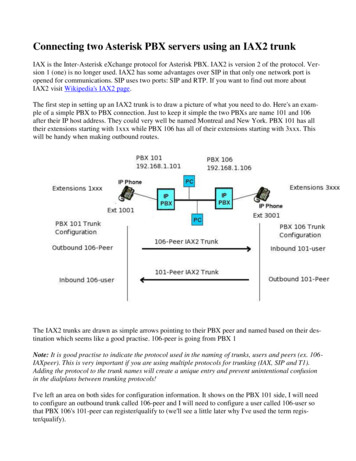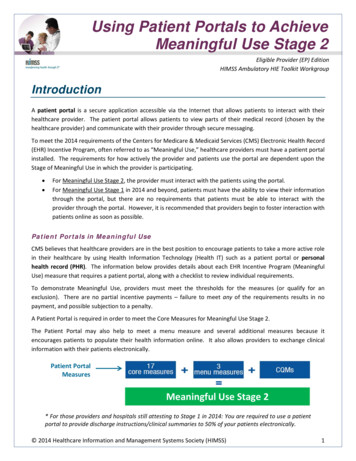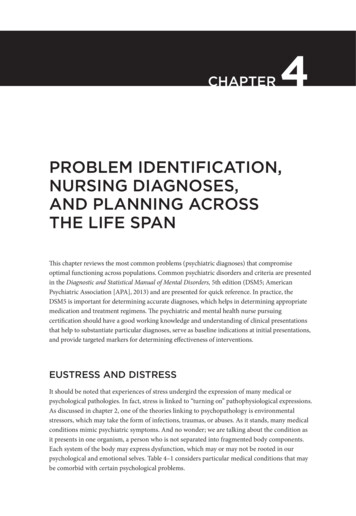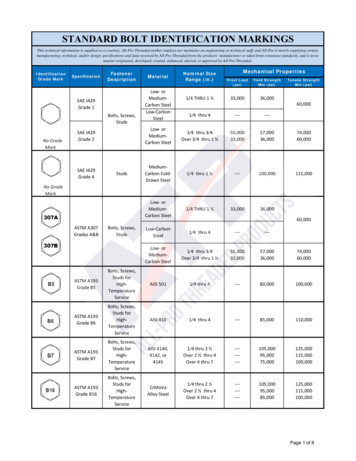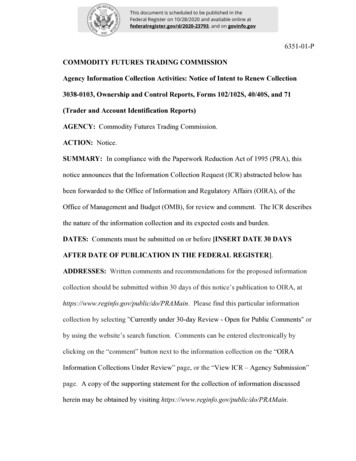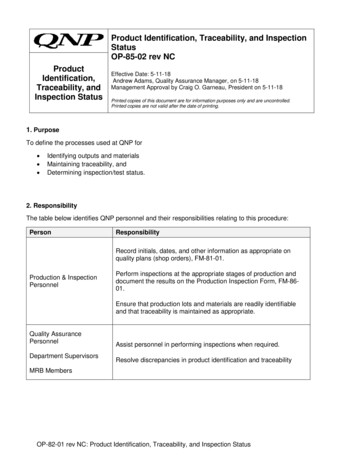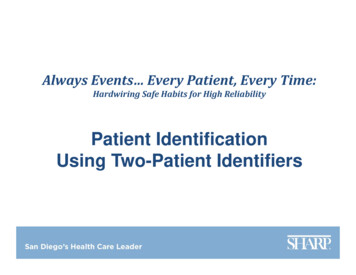
Transcription
Always Events Every Patient, Every Time:Hardwiring Safe Habits for High ReliabilityPatient IdentificationUsing Two-Patient Identifiers
Learning Objectives Describe error types and the importance of standardwork to achieve highly reliable processes Define acceptable patient identifiers Review the process of placing and replacing an armband Evaluate when to use two-patient identifiers Analyze the process for verifying patient identificationper SHC policy guidelines
Always Events Every Patient, Every TimeOur vision is to create a culture where these safepractices are hard-wired, patients are engaged, staffknow exactly what is expected, and they have thetools to make it easy to perform them for everypatient, every time.
Always Events Every Patient, Every TimeSharp HealthCare has identified 7 critical patient safety practices that weexpect to happen for every patient, every time. Our goal is to be a highreliability organization that habitually performs these 7 practices, whichwe refer to as Always Events.1.2.3.4.5.6.7.Patient identificationTreatment/Procedure verificationSix rights of medication administrationAlaris Guardrails Line reconciliationUniversal protocolHand hygiene
The Problem:Many Types of Patient Identification Errors1. Verifying a patient is who you think they are*2. Matching the service or treatment to the rightpatient*3.4.5.Choosing a patient’s name from a list of namesAssociating an object with patient’s name on a label ( e.g. specimen,belongings, telemetry monitors, etc.)Associating an object to another object (e.g. placing forms in chart,connecting a monitor, etc.)*Focus of 2014 Always Events initiative
Common Errors at Sharp & Across U.S. Diagnostic test performed on wrong patientMedication given to the wrong patientLab test performed on wrong patientPatient registered under the wrong name All errors, harmful or not, are considered seriousbecause they reveal failure points that couldpotentially lead to patient harm.
Patient Identification ErrorsCommon Causes and ContributorsReview of our adverse events and nearmisses revealed several common themeswhen errors occurred: The room number was relied on for patientidentification Caregivers stated the patient’s name ratherthan asking the patient to state their name Staff were rushed, distracted or interrupted,then left out critical steps of the two-patientidentifier process
Patient Identification ErrorsGeneral Causes and ContributorsThat Must Be AddressedSystem ProcessIssues No standard process, makesit difficult to cross-monitor Lack of clarity around whenand by whom it’s expected tocheck armband/patient labelTechnologyIssues Armband or label printer notworking Fading armbandsHuman FactorIssues rming an infrequentprocess
It Could Happen to Anyone Even careful, conscientious people makemistakes. The risk is often not obvious and can occur atany part of the patient identification process, ormay occur because an error in an earlierprocess wasn’t detected. Following the standard two-patientidentifier process would havelikely caught these errors. Using the standard two-patient identifierprocess every time protects yourpatients and yourself!
Patient Identification - Myth vs. FactMyth: I’ve been in healthcare for 10 years andI’ve never had a patient identification error.Fact: Most errors are first time errors; everyone isvulnerable no matter how careful they try to be.Myth: I’ve done it my way and it works for me.Fact: The new standard work process isdesigned to rigorously address risks that anindividual process may not. If everyone does itthe same way, it’s easier to cross-monitor oneanother.
Patient Identification - Myth vs. FactMyth : Double checking somethingwhen I am already certain is awaste of time.Fact: Mistakes in patient identification andtreatment verification have occurred even whenstaff knew the patient. Making the practice a habiteven when the risk seems low is how we hardwiresafe habits and create reliable systems. What wedo habitually is what we do in a hurry.
Patient Identification - Myth vs. FactMyth : Patients feel the service I provide is notpersonal if I keep asking them to say their name.They may feel like I keep forgetting.Fact: There may be some social awkwardnesswhen performing the two-patient identifierprocess numerous times for the same patient.Using key words and phrases that emphasize wefollow this process because safety is our prioritycan help.
Patient Identification - Myth vs. FactMyth : If I state the wrong patient’s name, theywill correct me.Fact: Many mistakes haveoccurred when staff have statedthe patient’s name and the patientagrees to the wrong name becauseeither the patient is confused,scared, doesn’t hear accurately orhas a language barrier.
Patient Identification - Myth vs. FactMyth : The person who brought me the patient,SURELY must have already identified the patient.Why would I need to double check someoneelse’s work?Fact: Each one of us represents a needed safetycheck in the system. Taking a shortcut byassuming others are always 100% perfect andnot performing our own safety check creates riskfor ourselves and our patients.
A True StoryWhen Name Only Was Used for Patient IDand Assumptions Were Made Patient A, was transferred from afacility outside Sharp. On admission,the demographics, health planinformation provided were that ofPatient B (same first and last name).Patient A was admitted under theMaster Patient Index number ofPatient B.Patient A’s correct date of birth wason the face sheet from the sendingfacility.The error was discovered afterdischarge by a SNF employee. Patient B received bills for Patient A’sstay. Service recovery was done withPatient B and it took over 20 hours tofix the records.Lesson Learned:1. Use two-patient identifiers habitually– even if you think someone elsealready checked.2. Since Patient A’s date of birth wascorrect on the face sheet, had theyused two-patient identifiers, theerror would have been discoveredat admission.
The Solution: Standard WorkStandard work is a written description of the safest, highestquality, and most efficient way to perform a process or task*and benefits include: Clearly defines specific stepsCaptures best, safest practiceReduces variationIncreases consistencyApplies to all settingsEasy to recognize deviation from the normAllows for cross-monitoringThe Standard Work for Patient Identification Using Two-Patient Identifiers isoutlined in SHC P&P # 30326.99.For special situations, refer to Refer to: P&P # 17022.99 Registration Standards,P&P 15307.99 Patient Secure – Palm Vein Scanning, and P&P #47404.99 – Infant Banding*Adapted from The Lean Handbook
National Patient Safety Goal - Patient ID Use at least TWO ways to identify patients when administering medications,blood, or blood components; when collecting blood samples and otherspecimens for clinical testing; and when providing treatments or procedures.* Acceptable Two-Identifiers Include: Name (First and Last) Date of Birth (DOB) Acceptable third-identifiers if DOB is not available/reliable: FIN # SHC # Medical Record Number Photo ID Blood Bank # (for blood administration)(Phone number and address are used with caution as family memberswith same name share phone #s and addresses)*The Joint Commission NPSG 2014
Unacceptable Patient IdentifiersThe following are NOT acceptable for patientidentifiers: Accession Number Diagnosis Procedure Patient’s Room/Bed number
A True StoryWhen Room Number is Used for Patient ID andAssumptions Are Made In the ED, Patient A in Bed 1 andPatient B in Bed 11, both had same firstname. A head CT was ordered forPatient A.The transporter hand-off form listed thepatient’s name correctly, but theradiology assistant inadvertently wroteBed 11 rather than Bed 1.The transporter used the bed numberto identify the patient and took thewrong patient to CT.Verification of the patient’s identity wasnot done on arrival in CT and the CTwas completed on the wrong patientLesson Learned:1.Use two-patient identifiershabitually2.Bed/Room number is NOT anacceptable patient identifier3.Patient identification MUST occurat admission, assuming care, priorto transfer, upon arrival to dept.,immediately prior to anymedication, treatment or procedure
When to Use Two-Patient Identifiers When placing or replacing an armband When assuming care of the patient (nursing) Prior to transferring the patient to another unit ordepartment (anyone who is transporting apatient) On arrival to a department (receiving provider) Immediately prior to any of the following: Medication administration Treatment, test or procedure including: imaging tests, labtests, transfusion, respiratory treatment or test, antenataltesting, physical therapy, EKG, etc. Prior to consultation by ancillary personnel
Standard Work for Placing an ArmbandIf patient is willing & able to participate ONEcare provider verifies patient identificationand involves the patient:If patient is NOT willing and able toparticipate, TWO care providers verifypatient identification:Step 1:Prior to placing the armband, confirmthe armband is accurate by asking, “Foryour safety, will you please spell yourlast name and state your first name andyour date of birth?Step 1:Prior to placing the armband, careprovider #1: Spells the patient’s last nameand states the first name and DOB from areliable source document (governmentissued ID or reliable photo ID).Step 2:Read back out loud from the armbandthe patient’s first and last name and DOB.Step 2:Care provider #2: Spells the patient’s lastname and states the first name and DOBout loud from the armband.
Changing an Armband If original band has incorrectpatient’s name or DOB: Remove the incorrect band Simultaneously replace with correct band Complete a Quality Variance Report If original band is unreadable or removed forclinical reasons (e.g. swelling, IV start, surgicalprocedure, etc.):oPlace new band on patient immediately after removing theold band or immediately after the procedure
A True StoryWhen There is No Double Check, the Risk ofError in a Critical Process is High Patient A presented to ED withextremely labored breathing and wasnot banded at the time of admission.A radiology tech arrived to do aportable chest x-ray, however could notdo it because the patient had noidentification band.The ED staff member handed the techa band, it was for Patient B.The radiology tech banded the patientwithout verifying the patient’s identity.The x-ray was taken and results wereplaced in Patient B’s medical record. The error was discovered when the patientwas admitted to the inpatient unit andpatient was re-banded with correctinformation.Lessons Learned:1. Place armbands ASAP onadmission.2. Habitually use two-identifiers andinvolve the patient (or a 2nd careprovider) prior to placing orreplacing an armband
Standard Work for Using Two-Patient IdentifiersRequires Reading Out Loud The new standard work requires: Confirming the patient’sname and DOB on thearmband as the patient issaying it out loud Staff reading patientidentifiers out loud from thesource document Reading the patient’s identifiersout loud improves safety* by: Forcing the provider’sattention on the task / createsmindfulness Engaging both auditory andvisual senses to help detectan error Allowing the task to be crossmonitored Engaging the patient*The Final Check, 2012
Standard Work for Using Two-Patient Identifierswith Armband in PlaceIf patient is willing and able to participate:If patient is NOT willing or able to participate(read it out loud twice):Step 1:Ask, “For your safety, will you pleasestate your name and your date of birth?”As the patient is responding, confirm thearmband is accurateStep 1:Confirm the armband is accurate byreading out loud the patient’s first and lastname and DOB.Step 2:Read back out loud the patients first andlast name and DOB from the verifyingdocument, (e.g. request, label, MAR,Order, etc.) and ensure it matches thearmbandStep 2:Read back out loud the patients first andlast name and DOB from the verifyingdocument, (e.g. request, label, MAR,Order, etc.) and ensure it matches thearmband
Standard Work for Using Two-Patient Identifierswith NO Armband in Place (Outpatient Visit)If patient is willing and able to participate:Step 1:Ask, “For your safety will you please stateyour name and your date of birth?” As thepatient is responding, confirm from theverifying document (request, label, MAR,order, Med label or photo ID) that nameand DOB are accurate.If patient is NOT willing or able toparticipate:Step 1:Confirm patient’s first and last name andDOB with a photo in EMR or a photo IDStep 2:Read back out loud the patient’s first andlast name and DOB from the request,label, MAR, order, Med label or photo IDand ensure it matches the armbandStep 2:Read back out loud the patients first andlast name and DOB from the request,label, MAR, order, Med label or photo IDand ensure it matches the armband
Example of Risk Created When StandardWork for Patient Identification is Not Followed Patient A’s full name (Lynn Smith*)was called from a waiting room foran x-ray. Patient B (with her mom) stood up andthe nurse asked if her name was“Lynn Smith”. She said, "yes". Patient Bspoke very little English. The nurse asked for her DOB and heard Patient B say, “five”.Patient B suddenly became unsteady and to prevent a fall,was hurried onto the x-ray table and x-rays were completed. After a few minutes, Patient A went to the front desk to sayshe thought the wrong patient was taken back, but was afraidto say anything at the time.*fictitious name Patient B received the wrong x-rays.
Frequently Asked Questions (FAQs) Why is there a change in the two-patient identifierprocess? Creating standard work regarding using two-patientidentifiers is an evidence-based practice which isrepeatable and making it a habit makes it a highlyreliable process for patient safety. Do I have to say “for your safety”? Saying “for your safety” or something similar willinform the patient why he or she is repeatedly askedto say or spell their name .They will expect thisprocess every time and understand that their safetyis our priority.
FAQs Do I need to do the Always Events process forpatient identification each time I see my patientthroughout the day? Yes, patient identification using two-identifiers is anAlways Event, which means that it needs to bedone for every patient, every time. Even if you are certain of the patient’s name, amajor part of the process is matching thetreatment, test or service to the right patient. Errorshave been detected and patient harm has beenminimized through performing this basic standardprocess for patient identification.
FAQs Why do I have to say or repeat the name out loud? Reading the name out loud improves focus andattention as well as makes the process crossmonitorable. When can the armband be removed? Armbands are to be removedat time of discharge by thedischarging RN or designeeand placed in a securecontainer to properly dispose ofprotected health information (PHI),unless patient prefers to keep the band
FAQs What if the patient is sleeping? If the patient is asleep and the procedure does notrequire them to be awakened, you can follow the “patientis NOT able” guideline. Read armband out loud, thenread source document out loud (e.g. label, order).**Excludes situations when a second provider is required. What if when admitting a patient, the patient/care partner isunable/unwilling and there are no source documents? Answer: If a patient cannot be identified, follow theUnidentified Patient- Identification and Family NotificationP & P (30012.99).
FAQs Does the patient identification process need to bedone when relieving for breaks / lunch? No, however, it should be performed with anytreatment, procedure or medication administeredduring the primary RN’s absence. Is this process still requiredwith barcoding? Barcoding is a technology thatprovides a process for verifying patient identification;however, it still requires a visual check to confirmpatient identity. Refer to the barcoding standardprocesses.
FAQs What if it is an emergency? Lifesaving efforts should not be delayed. Staff willneed to use critical judgment in an emergencysituation. I have never made an error with patientidentification before: why do I need to adopt thisprocess now? Even if you think you have never made an error it isprobable that you have or may do so in the future.Everyone is vulnerable to making errors, no matterhow careful they try to be.
Summary Patient identification errorshave common causes thatcan be addressed as systemprocess issues, technologyissues or human factor issues Contrary to common myths, errors can happen toanyone. Following the standard work process everytime protects your patients and yourself SHC policy guides standard work process for theconditions in which patient identification must befollowed.
References The Joint Commission 2014 National Patient Safety P NPSG Chapter 2014.pdf The Lean Handbook, Quality Press, 2012 and Jaiswal andAnderson,www.oregon.gov/DAS/trfm/docs/standard work.pptaccessed 11/1/2013 The Final Check; http://www.thefinalcheck.org/
Authors Team Members of the Always Events Patient IdentificationTask Force: Bernadette MartinezJaleisha Smith JacobsJori StuberKristy FillmoreChristine TillmanLaura WellnitzSherri Navedo Emily GouldKathleen NeumannAmanda Gastelum MunozJeanine Wagner-Woods*Patty Atkins*David Byron *Module Contact Person Module Created: December, 2013
Exit Click on the “X” (close button) in the upperright hand corner of the screen when you areready to complete the requirements for thiscourse.
issued ID or reliable photo ID). Step 2: Care provider #2: Spells the patient’s last name and states the first name and DOB out loud from the armband


